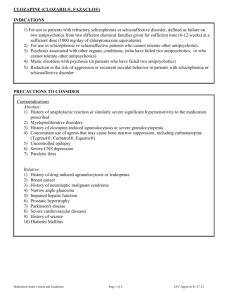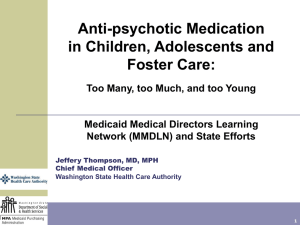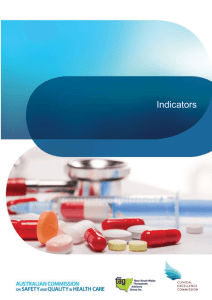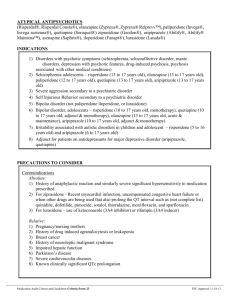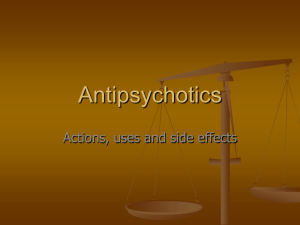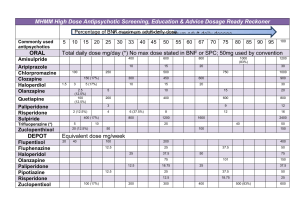Strategies for Dosing and Switching Antipsychotics for Optimal
advertisement
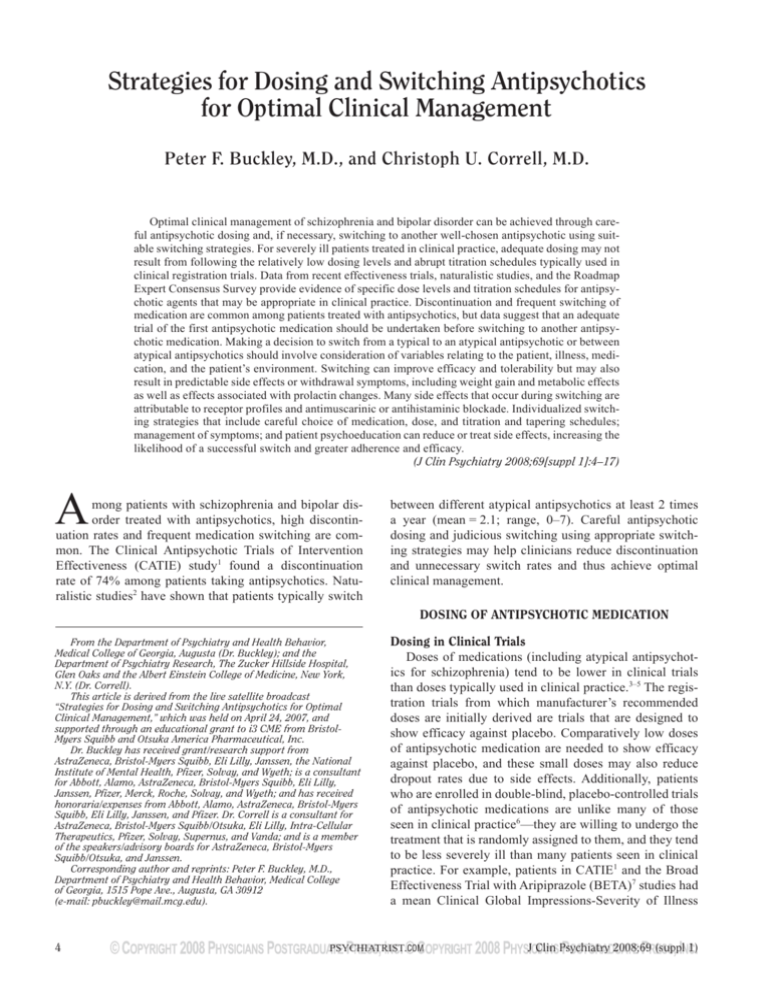
Buckley and Correll Strategies for Dosing and Switching Antipsychotics for Optimal Clinical Management Peter F. Buckley, M.D., and Christoph U. Correll, M.D. Optimal clinical management of schizophrenia and bipolar disorder can be achieved through careful antipsychotic dosing and, if necessary, switching to another well-chosen antipsychotic using suitable switching strategies. For severely ill patients treated in clinical practice, adequate dosing may not result from following the relatively low dosing levels and abrupt titration schedules typically used in clinical registration trials. Data from recent effectiveness trials, naturalistic studies, and the Roadmap Expert Consensus Survey provide evidence of specific dose levels and titration schedules for antipsychotic agents that may be appropriate in clinical practice. Discontinuation and frequent switching of medication are common among patients treated with antipsychotics, but data suggest that an adequate trial of the first antipsychotic medication should be undertaken before switching to another antipsychotic medication. Making a decision to switch from a typical to an atypical antipsychotic or between atypical antipsychotics should involve consideration of variables relating to the patient, illness, medication, and the patient’s environment. Switching can improve efficacy and tolerability but may also result in predictable side effects or withdrawal symptoms, including weight gain and metabolic effects as well as effects associated with prolactin changes. Many side effects that occur during switching are attributable to receptor profiles and antimuscarinic or antihistaminic blockade. Individualized switching strategies that include careful choice of medication, dose, and titration and tapering schedules; management of symptoms; and patient psychoeducation can reduce or treat side effects, increasing the likelihood of a successful switch and greater adherence and efficacy. (J Clin Psychiatry 2008;69[suppl 1]:4–17) A mong patients with schizophrenia and bipolar disorder treated with antipsychotics, high discontinuation rates and frequent medication switching are common. The Clinical Antipsychotic Trials of Intervention Effectiveness (CATIE) study1 found a discontinuation rate of 74% among patients taking antipsychotics. Naturalistic studies2 have shown that patients typically switch between different atypical antipsychotics at least 2 times a year (mean = 2.1; range, 0–7). Careful antipsychotic dosing and judicious switching using appropriate switching strategies may help clinicians reduce discontinuation and unnecessary switch rates and thus achieve optimal clinical management. DOSING OF ANTIPSYCHOTIC MEDICATION From the Department of Psychiatry and Health Behavior, Medical College of Georgia, Augusta (Dr. Buckley); and the Department of Psychiatry Research, The Zucker Hillside Hospital, Glen Oaks and the Albert Einstein College of Medicine, New York, N.Y. (Dr. Correll). This article is derived from the live satellite broadcast “Strategies for Dosing and Switching Antipsychotics for Optimal Clinical Management,” which was held on April 24, 2007, and supported through an educational grant to i3 CME from BristolMyers Squibb and Otsuka America Pharmaceutical, Inc. Dr. Buckley has received grant/research support from AstraZeneca, Bristol-Myers Squibb, Eli Lilly, Janssen, the National Institute of Mental Health, Pfizer, Solvay, and Wyeth; is a consultant for Abbott, Alamo, AstraZeneca, Bristol-Myers Squibb, Eli Lilly, Janssen, Pfizer, Merck, Roche, Solvay, and Wyeth; and has received honoraria/expenses from Abbott, Alamo, AstraZeneca, Bristol-Myers Squibb, Eli Lilly, Janssen, and Pfizer. Dr. Correll is a consultant for AstraZeneca, Bristol-Myers Squibb/Otsuka, Eli Lilly, Intra-Cellular Therapeutics, Pfizer, Solvay, Supernus, and Vanda; and is a member of the speakers/advisory boards for AstraZeneca, Bristol-Myers Squibb/Otsuka, and Janssen. Corresponding author and reprints: Peter F. Buckley, M.D., Department of Psychiatry and Health Behavior, Medical College of Georgia, 1515 Pope Ave., Augusta, GA 30912 (e-mail: pbuckley@mail.mcg.edu). 4 Dosing in Clinical Trials Doses of medications (including atypical antipsychotics for schizophrenia) tend to be lower in clinical trials than doses typically used in clinical practice.3–5 The registration trials from which manufacturer’s recommended doses are initially derived are trials that are designed to show efficacy against placebo. Comparatively low doses of antipsychotic medication are needed to show efficacy against placebo, and these small doses may also reduce dropout rates due to side effects. Additionally, patients who are enrolled in double-blind, placebo-controlled trials of antipsychotic medications are unlike many of those seen in clinical practice6—they are willing to undergo the treatment that is randomly assigned to them, and they tend to be less severely ill than many patients seen in clinical practice. For example, patients in CATIE1 and the Broad Effectiveness Trial with Aripiprazole (BETA)7 studies had a mean Clinical Global Impressions-Severity of Illness PSYCHIATRIST.COM J Clin Psychiatry 2008;69 (suppl 1) Strategies for Dosing and Switching Antipsychotics TAKE-HOME POINTS ◆ Choose initial medication carefully ◆ Before considering switching, optimize the dose of the current treatment to give it an adequate trial ◆ When deciding whether to switch, consider drug efficacy, receptor profile, tolerability, and safety, as well as variables regarding the patient, illness, and the patient’s environment ◆ Provide psychoeducation and involve the patient and family in the decision-making process ◆ Be vigilant for emerging side effects or withdrawal symptoms and treat them appropriately (add an antihistaminic medication or benzodiazepine if necessary) ◆ Be available to deal with problems (CGI-S) score of 4, which is moderate. Patients with substantial problems of suicidality, homicidality, or aggression and patients who have a refractory illness or comorbidities such as substance abuse are systematically excluded from placebo-controlled registration trials.6,8 In clinical practice, higher doses are often used for these patient subgroups, and this fact makes the evidence from clinical trials somewhat inadequate for practitioners who treat severely ill patients.8 In the first phase of the CATIE study,1 the largest effectiveness study in schizophrenia conducted to date (comprising 1493 patients), a broad range of dosing profiles among 5 medications (olanzapine, quetiapine, risperidone, ziprasidone, and perphenazine) was used (Table 1). The dosing profiles were decided by a group of senior psychiatrists in consultation with the trial drug manufacturers and were intended to reflect clinical practice at the time of the study. Although the participant selection criteria were broad in the CATIE study, and patients from 57 clinical sites (including university clinics, state mental health agencies, Veterans Affairs medical centers, private nonprofit agencies, private-practice sites, and mixed-system sites) in the United States participated, a limited number of refractory patients were included, and only about 4 of 10 participants achieved the maximum dose allowable in the trial. Olanzapine was the only drug for which the top of the dose range was an amount that was greater than the highest dose recommended by the U.S. Food and Drug Administration (FDA). As shown in Table 2, in phase 1 of CATIE, about one fourth of the patients taking quetiapine, risperidone, ziprasidone, or perphenazine discontinued treatment owing to lack of efficacy. Compared with the perphenazine, quetiapine, and risperidone groups, the olanzapine group had significantly longer time to discontinuation of treatment for lack of efficacy (p < .001). The comparison with the ziprasidone group was not significant (p = .026; p ≤ .013 after adjustment for multiple comparisons). Olanzapine had the lowest dropout rate because of lack of efficacy but the highest dropout rate owing to lack of tolerability; J Clin Psychiatry 2008;69 (suppl 1) however, the differences between the groups in time to discontinuation due to intolerable side effects were not significant (p = .054). Dosing in Clinical Practice The CATIE study, being a hybrid between a typical randomized controlled clinical trial and an effectiveness study that matches naturalistic clinical practice more closely, illustrated some dosing tendencies in clinical practice.1 Clinicians in CATIE tended to choose doses at about two thirds of the given range, which is common when physicians are given a capped dose range. In the CATIE study, dosing for olanzapine was higher because the dose range of olanzapine was capped at a dose 50% higher than the Physicians’ Desk Reference (PDR)– recommended dose.9 Another tendency in clinical practice may be to switch medication before optimizing the current medication dose or optimizing management of side effects. Essock et al.10 compared outcomes of CATIE patients who were randomly assigned to remain on the same medication they were taking at baseline (olanzapine or risperidone) versus the outcomes of patients who were switched to a different antipsychotic. A significantly lower (p = .007) discontinuation rate was found for those who continued their medication versus those who were switched. These data suggest that switching too early in treatment may be an inefficient treatment strategy. Citrome and colleagues’ study11 of antipsychotic medication dosage for patients in New York state psychiatric hospitals showed a growing tendency toward higher dosing between 2001 and 2006, although the percentage of patients who received a high daily dose of aripiprazole was lower than that of patients taking other secondgeneration antipsychotics (Figure 1). High dosing is used rarely with clozapine or risperidone,12 likely due to the disproportionate rise in the risk of seizures, sedation, and anticholinergic side effects for clozapine at doses above 900 mg/day and the risk of extrapyramidal side effects (EPS) for risperidone at doses above 8 mg/day, without PSYCHIATRIST.COM 5 Buckley and Correll Table 1. Dosing Comparison of 5 Antipsychotic Drugs in Patients With Chronic Schizophrenia From the CATIE Studya Outcome Dose Olanzapine Quetiapine Dose range, mg/day 7.5–30 200–800 Mean modal dose, mg/day (total no. of patients) 20.1 (312) 543.4 (309) Maximum dose received, no. of patients (%) 124 (40%) 137 (44%) a Data from Lieberman et al.1 Abbreviation: CATIE = Clinical Antipsychotic Trials of Intervention Effectiveness. Risperidone 1.5–6 3.9 (305) 122 (40%) Ziprasidone 40–160 112.8 (165) 80 (48%) Perphenazine 8–32 20.8 (245) 98 (40%) Table 2. Discontinuation Rates in Patients With Chronic Schizophrenia From the CATIE Studya Reason for Discontinuation Olanzapine, N (%) Quetiapine, N (%) Risperidone, N (%) Lack of tolerability 62 (19) 49 (15) 34 (10) Lack of efficacy 48 (15) 92 (28) 91 (27) a Data from Lieberman et al.1 Abbreviation: CATIE = Clinical Antipsychotic Trials of Intervention Effectiveness. Ziprasidone, N (%) 28 (15) 44 (24) Perphenazine, N (%) 40 (16) 65 (25) Figure 1. Percentage of Patients in New York State Psychiatric Hospitals Who Received a High Daily Dose of an Antipsychotica,b 60 Ziprasidone > 160 mg/day Olanzapine > 20 mg/day Aripiprazole > 30 mg/day Quetiapine > 750 mg/day Patients (%) 50 40 30 20 10 0 2001 2002 2003 2004 2005 2006 Calendar Year a Reprinted with permission from Citrome et al.11 Percentage calculated by dividing the number of patients receiving the drug of interest at a dosage above the designated threshold by the total number of patients receiving the drug of interest. b evidence for substantial gains in efficacy. Citrome and colleagues’ study11 suggests a trend toward attempting to achieve optimal efficacy for an antipsychotic by increasing doses before switching to another agent. However, it should be borne in mind that this study comprised a substantial number of refractory, long-stay patients who would have been excluded from trials like the CATIE study because they were more severely ill. Further, it is unclear from this study whether the dose increase yielded better results. Compared with long hospitalization, the more common, relatively short hospitalization experienced by most patients in typical hospital systems may make reaching the highest tolerated doses less likely, since it can take 2 to 4 weeks to achieve a therapeutic dose with some atypical antipsychotics. Besides switching too soon, another tendency in clinical practice is to start polypharmacy instead of optimizing the current antipsychotic dose. If the patient tolerates 6 the current antipsychotic dose but has experienced only minimal gains, sometimes another antipsychotic is added before the dose of the first medication is maximized above PDR-recommended dose levels that were derived from trials of less severely ill and refractory patients. However, adequate dosing can be problematic in clinical practice. Adequate dosing varies from patient to patient and depends on severity and chronicity of illness, susceptibility to adverse effects, and whether the patient is an extensive or a slow metabolizer.6 Since dose response differs greatly between patients, clinicians typically titrate until efficacy or side effects occur, or the maximum recommended dose is reached, and then they may either augment or switch. Clinicians may be reluctant to increase the antipsychotic medication doses above the PDRrecommended ranges, but they need to remember that the patient they treat may not be the type of patient who participated in the studies from which the dose ranges were PSYCHIATRIST.COM J Clin Psychiatry 2008;69 (suppl 1) Strategies for Dosing and Switching Antipsychotics Table 3. Initial Dose and Titration Schedule Based on the Roadmap Expert Consensus Survey for a First-Episode Patient With Schizophrenia and With No Complicating Conditions Affecting Dosinga,b Medication Aripiprazole Olanzapine Quetiapine Usual Starting Dose (mg/day), Avg (range) 10 (5–15) 10 (5–15) 150 (50–250) Risperidone 1.5 (1–2) Ziprasidone Haloperidol 60 (40–100) 3 (1–4) a Interval Between Dose Increases 1 week 1 week 3 days (but wide range) 1 week (but wide range) 4 days 1 week Usual Dose Increment, mg 5 or 10 5 150 (but wide range) 1.5 (but wide range) 40 or 60 2–4 Usual Initial Target Dose (mg/day) Low, High, Avg (range) Avg (range) 10 (5–15) 25 (20–30) 10 (7.5–12.5) 22.5 (20–30) 300 800 (600–1000) (but wide range) 2 (1–3) 6 (5–8) 100 (60–140) 5 (2–8) 200 (160–240) 10 (10–15) Reprinted with permission from Weiden et al.14 Mean doses and standard deviations from survey results converted to “real world” doses. b derived. Higher doses may be needed with some drugs, such as quetiapine and ziprasidone, for which underdosing may have occurred in the registration trials. It is not clear whether doses above 30 mg/day of aripiprazole are effective or have been tried. Of all marketed antipsychotics, aripiprazole is the atypical antipsychotic that has the highest affinity on the dopamine-2 (D2) receptor, but it is also a partial agonist; at higher doses, the partial agonism may be reduced, as indicated by a dose response curve for parkinsonian side effects,13 and may lead to greater efficacy in some patients who require greater D2 blockade. Phase IV studies of atypical antipsychotics allowing flexible dosing above the PDR-recommended dose levels will provide better guidance on dosage in generalizable practice settings. Titration can also be problematic in clinical practice in terms of the optimal number of dosage increase steps and the time required to reach adequate efficacy. For example, once-a-day dose increases may be appropriate for quetiapine and ziprasidone, which have only a 7-hour half-life. However, different titration schedules may be needed for drugs that have longer half-lives, particularly aripiprazole, with which the full effect may not be seen until 10 to 14 days after the dose increase. In addition, aripiprazole may induce early side effects of restlessness or agitation due to its partial agonism if the initial dose is too high,14 especially if the dopamine system is up-regulated due to prior antipsychotic use or hypodopaminergia in some brain regions. Dosing Guidelines Evidence-based findings from the Roadmap Expert Consensus Survey14 were combined with expert opinion to create expert consensus dose and titration recommendations for antipsychotics for patients with first-episode schizophrenia (Table 3). Comparative dosing for firstepisode versus chronic illness is not available for all agents, but as a general rule, dose requirements during the first psychotic episode are approximately half of the doses needed for chronically ill patients. J Clin Psychiatry 2008;69 (suppl 1) In the future, guidance regarding choice of medication and dosing may be provided by the pharmacogenomics of the cytochrome P450 (CYP) system and study of the genes CYP2D6, CYP3A3, and CYP3A4; more information may be available regarding the patient’s drug metabolism speed and likelihood of side effects such as weight gain, sedation, and extrapyramidal side effects.15,16 Until more pharmacogenomic information is available, the Roadmap Expert Consensus Survey14 provides useful guidance regarding dosing, titration, and switching. The following case illustrates many issues surrounding choice of medication. Case report 1. Ms. A, a 40-year-old woman diagnosed with schizoaffective disorder, was treated at a psychiatric institution. She had been treated for depression in the past, but with each pregnancy, her depression worsened. Her final pregnancy was accompanied by not only depression but also psychosis. Ms. A was prescribed another antidepressant in the hospital, but when her depression worsened, she and her clinicians decided to discontinue the medication, which had been considered her last chance at treatment. As a result of her experiences, Ms. A was “frustrated with medicines,” doubting their efficacy and having little confidence that switching to another medication would have a better result. She believed that “there were other factors” besides medication. Weary of switching medications, Ms. A stated that she would be excited just to get to the point where she was stable on 1 medicine. This case illustrates the difficulty of treating both psychosis and depression and the frustration that patients face when they do not achieve stability on a particular medication and want greater improvement in their health and functioning. Patients want a simple treatment option but may realize that medication is not the only answer for full recovery. Additionally, if the first medication choice does not work, the patient may become hesitant to taking a different medication, and patients and clinicians both have to weigh risks and benefits of medications with each switch. PSYCHIATRIST.COM 7 Buckley and Correll DECIDING WHETHER TO SWITCH ANTIPSYCHOTIC MEDICATION effects. The following case shows that switching can be a difficult issue for patients. Reasons for Switching The 2 most common reasons for switching antipsychotic medication are lack of efficacy and occurrence of adverse effects. Opportune times to switch antipsychotic medication are during hospitalization for a relapse, during outpatient treatment when the patient is not in crisis and has strong social support, and when the patient wants to switch.17,18 Switching from typical to atypical antipsychotics. Common reasons to switch from typical to atypical antipsychotics in patients with schizophrenia include inadequate response of positive symptoms and residual negative symptoms such as lack of motivation, anhedonia, and depression. Mood disorders or cognitive dysfunction can also provoke a switch from typical to atypical antipsychotic medication. Adverse effects such as EPS, including the distressing effects of akathisia and tardive dyskinesia, can lead to a switch to a medication with a lower risk for these symptoms. Relapse despite compliance is another cause to switch, and noncompliance can lead to a switch to a medication with a more tolerable side effect profile. Now that people have many sources of information, such as the Internet and magazine or television advertisements, patients or their families seeking better outcomes or newer medications may provide further reasons to switch. In patients with bipolar disorder, depression may be induced by first-generation antipsychotics,19 and a switch may be appropriate.17,18 Switching between atypical antipsychotics. The main reasons to switch between atypical antipsychotics are to improve efficacy and reduce side effects. Partial response to the initial antipsychotic may result in residual psychosis or in mood symptoms. A range of side effects can occur depending on the action of the particular antipsychotic. All atypical antipsychotics act as dopamine antagonists when dosed appropriately. However, they differ in their effects on other neuroreceptor systems, including serotonin, which is related to efficacy for depressive symptoms and anxiety. Some atypical antipsychotics cause more sedation, weight gain, and possibly decreased cognitive function than others due to antimuscarinic effect (clozapine, olanzapine, and quetiapine). Others, such as risperidone, may cause more EPS or prolactin and sexual side effects.17 Advantages and Disadvantages of Switching Between Antipsychotics Some debate surrounds the efficacy of switching between antipsychotics. Switching can be an effective strategy, but clinicians should not rush into switching antipsychotic medication until they have maximized the dose of the current medication and taken steps to manage side 8 Case report 2. Ms. B, a 32-year-old woman, was clearly psychotic on first presentation, believing that she had ants in her brain. She was very distressed, had put disinfectant in her ears, and had shaved her hair. The first medication she received caused her to experience breast tenderness (probably due to hyperprolactinemia) and anxiety (probably akathisia), and she was reluctant to continue taking it. At her second presentation, Ms. B agreed to switch to another medicine but was concerned that she was being “tricked” into taking 2 antipsychotics simultaneously and threatened to stop taking all medications. Support from Ms. B’s family and the treatment team and an agreement that the treatment would be reviewed after about 8 weeks finally persuaded Ms. B to switch medication. Ms. B expected to see an immediate benefit from the new medication, and she found cross-titration difficult to understand and the prospect of the prolonged side effects of the first medication during the cross-titration period hard to tolerate. Variables to Consider Regarding Dosing and Switching The variables that physicians should take into account when considering antipsychotic dosing and switching include patient, illness, medication, and environmental characteristics (Table 4). It is difficult for clinicians to consider all of the possible variables, but the following are particularly important: • • • • • • • past response to medication patient beliefs about medication severity of illness efficacy of the medication predictable side effects dosing schedule the patient’s environment Past response to medication is associated with behavior regarding adherence and with beliefs about medication. Patients who have previously discontinued medication because of weight gain or sedation are likely to do so again if they experience the same side effects. Patients like Ms. B who do not want to be on too many medications are likely to have difficulty accepting multiple medications overlapping during switching. Among the illness variables, severity of illness is important because severely ill patients, whether they are first-episode or multi-episode patients, may need to quickly reach optimum doses or be switched more rapidly than less severely ill patients. For clinicians and patients, the most important variable tends to be efficacy. Patients may have certain expectations such as the medication must provide antianxiety benefit or, as Ms. A hoped, antidepressant efficacy. Individual patients may have their own views regarding which side effects are of most consequence. Pharmacologic profiles are an PSYCHIATRIST.COM J Clin Psychiatry 2008;69 (suppl 1) Strategies for Dosing and Switching Antipsychotics Table 4. Variables Relevant to Individualized Antipsychotic Dosing and Switching Patient Beliefs about potential risks and benefits Expected duration of treatment Past response (efficacy and tolerability) Past adherence Therapeutic alliance Brain biology Illness Symptom type and severity/acuity Duration (first-episode, multi-episode, or chronic) Responsiveness (response, remission, recovery, deteriorating, relapsing, chronic, refractory) Comorbidities (medical, psychiatric) important medication variable that can affect compliance—patients who are told what to expect in terms of predictable side effects and dosage complexity may be more prepared to cope with these difficulties. The variable of the patient’s environment and the degree of structure, supervision, and support can also determine choice of treatment. Little evidence suggests major efficacy differences across antipsychotic agents, except for clozapine in refractory patients, but reducing side effects improves tolerability and therefore may improve compliance, which in turn may translate into enhanced efficacy. Benefits of Switching CATIE1 and BETA7 provided evidence concerning the reasons for discontinuation and switching of antipsychotics. In CATIE,1 74% of patients discontinued medication before 18 months, and the main reasons for doing so were lack of satisfaction with efficacy and concerns about tolerability. At entry to BETA,7 similar reasons for changing medication were found, but specifically, dissatisfaction with the efficacy of antipsychotic medication for positive and negative symptoms and concern about side effects (particularly weight gain) were prominent. A wide range of potential advantages may be gained by switching antipsychotics, but the choice of antipsychotic should be tailored to the needs of the individual patient. Possible advantages of switching to or among atypical antipsychotics are listed in Table 5.7,10,20–39 Switching for Efficacy Several studies have examined switching antipsychotics to improve efficacy. Weiden and colleagues24 evaluated patients switched to ziprasidone from conventional antipsychotics, olanzapine, or risperidone. Over the 6-week trial, symptoms showed a significant (p < .05) improvement from baseline according to the Positive and Negative Syndrome Scale (PANSS) scores, and the greatest improvement was seen in patients switching from conventional antipsychotics. In the Essock et al. analysis10 of patients who continued or switched to risperidone or olanzapine in the CATIE study,1 a smaller percentage of participants who were tak- J Clin Psychiatry 2008;69 (suppl 1) Medication Efficacy and effectiveness Tolerability and safety Pharmacodynamics (receptor profile and occupancy) Pharmacokinetics (metabolism, bioavailability, half-life) Comedications Complexity (dosing, titration) Delivery system/formulation Cost/availability Environment Structured, supervised Support system ing olanzapine than risperidone dropped out for lack of efficacy, whether they were continuing the same treatment or had been switched. Aripiprazole was added late to the CATIE study, but the BETA study7 showed improved efficacy of switching to aripiprazole, as measured by Clinical Global Impressions-Improvement (CGI-I) scores, compared with standard care with risperidone, olanzapine, or quetiapine in moderately ill patients. Ritchie and colleagues23 showed that core symptoms of schizophrenia were reduced and quality of life improved in elderly patients by switching from a conventional antipsychotic to olanzapine or risperidone. Compliance and quality of life were both improved through increased level of insight and beneficial cognitive effects when patients were switched from haloperidol to clozapine, risperidone, or olanzapine.20 Cognition and symptoms related to cognitive function were improved by switching to ziprasidone from conventional antipsychotic medication, risperidone, or olanzapine22 or switching to olanzapine from clozapine, risperidone, or haloperidol.21 Efficacy against psychotic symptoms was improved in over 50% of patients with schizophrenia who were switched to ziprasidone from conventional or atypical antipsychotics.33 Clozapine may provide greater effectiveness for patients with schizophrenia who responded poorly to another atypical antipsychotic.25 A longitudinal study in a community-based setting30 found that switching from a typical antipsychotic to an atypical antipsychotic improved quality of life and reduced the need for hospitalization and community support in stable outpatients with schizophrenia. Prosocial functioning improved among patients with schizophrenia who were switched to ziprasidone from conventional antipsychotics, risperidone, or olanzapine.22 Switching for Tolerability Studies have provided information regarding switching to decrease side effects. Although individual patients differ, the side effect risk profile of different agents is fairly predictable. However, expected changes after a medication switch depend on what the preswitch and postswitch agents were, as shown in Figure 2.1,40–47 For example, switching to quetiapine or olanzapine from agents such as ziprasidone, aripiprazole, or even risperidone that have a lower PSYCHIATRIST.COM 9 Buckley and Correll Table 5. Possible Benefits From Switching Antipsychotic Medications Studies Showing Improvement Adherence to medications Aguglia et al20 Cognition Aguglia et al20 Lindenmayer et al21 Loebel et al22 Core schizophrenia symptoms Ritchie et al23 Weiden et al24 Effectiveness Essock et al10 McEvoy et al25 Tandon et al7 Extrapyramidal symptoms De Nayer et al26 Lang et al27 Lindenmayer et al28 Van Os et al29 Ganglia volume (reduced) Lang et al27 Hospitalization and community support (reduced need for) Cook et al30 Hyperprolactinemia Kaneda et al31 Nakajima et al32 Motor side effects Ritchie et al23 Prosocial functioning Loebel et al22 Psychotic symptoms Bartko et al33 Weiden et al24 Quality of life Aguglia et al20 Cook et al30 Ritchie et al23 Safety profile Bartko et al33 Weight changes and metabolic issues De Hert et al34 Meyer et al35 Montes et al36 Pigott et al37 Ried et al38 Su et al39 Weiden et al24 Switch From Haloperidol Clozapine, risperidone, or olanzapine Haloperidol Clozapine, risperidone, or haloperidol Typical antipsychotics, risperidone, or olanzapine Clozapine, risperidone, or olanzapine Olanzapine Ziprasidone Typical antipsychotic Conventional or atypical antipsychotic Olanzapine or risperidone Ziprasidone Quetiapine, risperidone, or ziprasidone Olanzapine, quetiapine, risperidone, or ziprasidone Ziprasidone, risperidone, quetiapine, olanzapine, clozapine, or typical antipsychotic Olanzapine Clozapine Aripiprazole Typical or atypical antipsychotics Typical antipsychotics or risperidone Haloperidol, quetiapine, or olanzapine Typical antipsychotics Quetiapine Olanzapine Long-acting risperidone Long-acting risperidone Typical antipsychotics or risperidone Olanzapine Typical antipsychotic Atypical antipsychotic Typical antipsychotics Typical antipsychotics Olanzapine, perospirone, or quetiapine Quetiapine Typical antipsychotics Olanzapine Typical antipsychotics, risperidone, or olanzapine Ziprasidone Typical antipsychotic or atypical antipsychotic Conventional or atypical antipsychotic Ziprasidone Ziprasidone Haloperidol Typical antipsychotic Typical antipsychotics Clozapine, risperidone, or olanzapine Atypical antipsychotic Olanzapine Typical antipsychotic or atypical antipsychotic Ziprasidone Typical antipsychotic or atypical antipsychotic Olanzapine Risperidone and olanzapine Typical antipsychotic or atypical antipsychotic Olanzapine Olanzapine Risperidone and olanzapine Aripiprazole Risperidone Ziprasidone Aripiprazole Risperidone Risperidone Ziprasidone risk for weight gain and lipid increase may result in a higher risk for weight gain. Switching from an agent with little effect on prolactin to risperidone could result in more sexual side effects. Similarly, patients may complain about sedation when switching from an agent like aripiprazole or ziprasidone which has a low risk of sedation, to quetiapine or olanzapine. Essock and colleagues’ reanalysis of CATIE10 found that a higher number of patients switched to olanzapine discontinued for intolerability compared with patients switched to risperidone or those who stayed on olanzapine or risperidone treatment. Before a switch, the relativity of side effects in terms of the profiles of the preswitch agent and the postswitch agent should be considered. 10 Switch To Motor side effects. Extrapyramidal symptoms may be reduced in patients switched to olanzapine from typical antipsychotics.27 Among elderly patients with schizophrenia, dyskinetic symptoms were reduced when patients were switched to olanzapine from conventional antipsychotic medication.23 Like olanzapine and ziprasidone, risperidone causes dose-dependent increases in EPS,48 but a switch to risperidone may be appropriate for some patients. Extrapyramidal symptom rating scale scores were reduced in patients switched from oral haloperidol, quetiapine, or olanzapine to long-acting risperidone28 and in patients switched from conventional antipsychotics to long-acting risperidone.29 Switching to quetiapine from typical or atypical antipsychotics (including olanzapine PSYCHIATRIST.COM J Clin Psychiatry 2008;69 (suppl 1) Strategies for Dosing and Switching Antipsychotics Figure 2. Estimated Changes in Weight, Metabolic, and Endocrine Parameters After Switching Antipsychotic Medicationsa–d Postswitch Antipsychotic Conventionale Preswitch Antipsychotic Conventionale Olanzapine Quetiapine Risperidone Ziprasidone Aripiprazolef ↑↑ Weight ↑↑ Lipids ↓ Prolactin ↑ Weight ↑ Lipids ↓ Prolactin ↑↑ Weight ≈ Lipids ↑ Prolactin ≈ Weight ≈ Lipids ↓ Prolactin ≈ Weight ≈ Lipids ↓ Prolactin ↓ Weight ↓ Lipids ≈ or ↓ Prolactin ↓ Weight ↓ Lipids ↑↑ Prolactin ↓↓ Weight ↓↓ Lipids ≈ Prolactin ↓↓ Weight ↓↓ Lipids ≈ or ↓ Prolactin ≈ Weight ≈ or ↓ Lipids ↑↑ Prolactin ↓ Weight ↓ Lipids ≈ Prolactin ↓ Weight ↓ Lipids ≈ Prolactin ↓ Weight ≈ or ↓ Lipids ↓↓ Prolactin ↓ Weight ≈ or ↓ Lipids ↓↓ Prolactin Olanzapine ↓↓ Weight ↓↓ Lipids ↑ Prolactin Quetiapine ↓ Weight ↓↓ Lipids ↑ Prolactin Risperidone ↓ Weight ≈ Lipids ≈ or ↓ Prolactin Ziprasidone ≈ Weight ≈ Lipids ↑ Prolactin ↑↑ Weight ↑↑ Lipids ≈ Prolactin ↑ Weight ↑ Lipids ≈ Prolactin ↑ Weight ≈ or ↑ Lipids ↑↑ Prolactin Aripiprazolef ≈ Weight ≈ Lipids ↑ Prolactin ↑↑ Weight ↑↑ Lipids ≈ Prolactin ↑ Weight ↑ Lipids ≈ Prolactin ↑ Weight ≈ or ↑ Lipids ↑↑ Prolactin ↑ Weight ↑ Lipids ≈ Prolactin ↑ Weight ↑↑ Lipids ↓↓ Prolactin ≈ Weight ≈ or ↑ Lipids ↓↓ Prolactin ≈ Weight ≈ Lipids ≈ or ↓ Prolactin ≈ Weight ≈ Lipids ≈ Prolactin a Reprinted with permission from Weiden.40 Data from Lieberman et al.1 unless otherwise noted. c These are estimates-based differences between preswitching and postswitching values, with the latter being obtained at least 2 weeks after monotherapy with postswitch antipsychotic. d Table symbols refer to the estimated magnitude of preswitch and postswitch differences, with “≈” indicating no change, single arrows indicating increase or decrease, and double arrows indicating a common and clinically significant problem. e Here, “conventional” refers to high-potency conventional antipsychotics such as haloperidol or fluphenazine. Low-potency conventional antipsychotics will have greater weight gain liability. f Data on aripiprazole were not obtained from the CATIE study but are based on other “switch” studies41–47 that show a similarity to the profile of ziprasidone in terms of effect on weight and metabolic side effects. b or risperidone) in patients with schizophrenia was found to significantly (p < .001 vs. baseline) reduce EPS according to the Simpson-Angus Scale and the Barnes Akathisia Scale.26 Switching to quetiapine from a typical antipsychotic may also be appropriate to reduce existing tardive dyskinesia, and switching to quetiapine from another atypical antipsychotic may be appropriate for new-onset tardive dyskinesia.48,49 Prolactin-associated side effects. Prolactin-associated side effects, such as galactorrhea, breast engorgement (as Ms. B reported), menstrual disturbance, and sexual dysfunction, vary across atypical antipsychotics, which are either prolactin-sparing or prolactin-inducing. Hyperprolactinemia was reduced in about two thirds of women switched to quetiapine from conventional antipsychotic medication,32 and prolactin levels were reduced in male schizophrenia patients switched to olanzapine, perospirone, or quetiapine from typical antipsychotics.31 In a naturalistic trial50 that compared change in serum prolactin levels in 555 patients treated with either aripiprazole or standard care (olanzapine, quetiapine, or risperidone) for 26 weeks, prolactin levels were significantly lower in J Clin Psychiatry 2008;69 (suppl 1) the group treated with aripiprazole (–32.1 ± 1.8 vs. –12.3 ± 1.9 mg/dL; p < .001). Weight gain and metabolic effects. Some patients may benefit from a medication switch because of weight gain or metabolic side effects.38 In the 26-week schizophrenia trial of aripiprazole,51 in which 555 patients were randomly assigned to either aripiprazole or standard care with olanzapine, quetiapine, or risperidone, less than 10% of patients treated with aripiprazole experienced a weight gain greater than 7% of their body weight, compared with over 20% of patients receiving standard care. The mechanism underlying weight gain, satiety, and appetite dysregulation may help explain why patients report feeling hungry or eating more when they are treated with agents that act as histamine-1 (H1) antagonists. Evidence is limited, but a study by Kim and colleagues52 suggested that the appetite stimulation of atypical antipsychotics may be mediated by activation of hypothalamic AMP-kinase (AMPK) linked to blockade of the H1 receptor. AMPK stimulation paralleled the orexigenic actions of the medications studied and was most marked with clozapine, olanzapine, and quetiapine. In contrast, risperidone, PSYCHIATRIST.COM 11 Buckley and Correll Figure 3. Changes in Fasting Triglyceride Levels After Switching Antipsychotic Medicationsa 50 ** Median Change (mg/dL) 40 30 ** 20 10 0 –10 –20 * –30 –40 ** –50 Ziprasidone (N = 34) Risperidone (N = 28) Olanzapine (N = 27) Quetiapine (N = 29) Thioridazine (N = 31) Haloperidol (N = 29) a Data from Pfizer FDA Briefing Document.53 Change from baseline to peak exposure at end of study (15–25 days). *p < .01. **p < .001. ziprasidone, haloperidol, and aripiprazole, medications that are found to be less orexigenic, failed to stimulate AMPK. Differences in effects on fasting triglyceride levels were also found between agents in a short, open-label, parallelgroup study53 of the effects of ziprasidone, risperidone, olanzapine, quetiapine, thioridazine, or haloperidol in patients with schizophrenia (Figure 3). By the end of the study, considerable differences in the change in triglyceride levels produced by the 6 agents were found. Ziprasidone, risperidone, and haloperidol produced a reduction in fasting triglyceride levels, whereas olanzapine, quetiapine, and thioridazine produced an increase in fasting triglyceride levels. Effects on weight and lipid levels in patients treated with olanzapine and aripiprazole were compared in a multicenter, randomized, double-blind trial54 of relapsed, hospitalized patients with schizophrenia. When last-observation-carried-forward (LOCF) analysis was performed, a greater number of patients treated with olanzapine compared with those treated with aripiprazole (33% vs. 13%) experienced significant (p < .001) weight gain, and at the end of the 26-week trial, patients treated with olanzapine had a worse lipid profile with greater increases in fasting triglyceride levels (p < .05) compared with those treated with aripiprazole. Switching patients to more weight-neutral compounds may help reverse triglyceride abnormalities and weight gain. Weiden and colleagues’ 1-year study,55 an extension of the 6-week study24 of patients switched to ziprasidone from conventional antipsychotics or olanzapine or risperidone, showed that weight gain decreased in a linear fashion over time but that lipid levels fell more rapidly initially and then flattened out. Marcus and colleagues56 also demonstrated a decrease in weight and lipids in overweight 12 patients switched to aripiprazole from olanzapine in a 4-month trial. Several of these studies demonstrated that switching to a lower-risk agent can be effective in terms of lowering metabolic risk in addition to weight loss. SWITCHING STRATEGIES FOR ANTIPSYCHOTIC MEDICATION Switching Options As shown in Figure 4, several tapering options are available when switching antipsychotics17,57: (1) stop one antipsychotic abruptly and immediately start the new antipsychotic, (2) gradually taper the current agent and immediately start the new antipsychotic, (3) cross-taper by gradually tapering the current agent while gradually starting the new antipsychotic, and (4) plateau cross-titrate by continuing the first antipsychotic at full dose while gradually bringing the second agent to full dose and then tapering the first medication. Historically, little empirical evidence has provided guidance regarding switching strategies.58 Although abrupt switches may be used in clinical trials, in clinical practice, many clinicians favor cross-titration rather than an abrupt stop-and-start strategy. Plateau cross-titration may be particularly appropriate for aripiprazole because it has a long half-life and takes longer to build up than some other agents. Unspecified rescue medications are often used in controlled trials to counter problems, a usage that is frequently not matched by clinical practice.59 Problems With Switching Many of the predictable problems that can occur when switching between antipsychotic medications revolve PSYCHIATRIST.COM J Clin Psychiatry 2008;69 (suppl 1) Strategies for Dosing and Switching Antipsychotics Figure 4. Antipsychotic Switching Strategiesa Current Antipsychotic New Antipsychotic Overlap of Current and New Antipsychotic Dose Abrupt Switch Immediate Discontinuation of Previous Antipsychotic Patient Psychoeducation Some key psychoeducation messages can help patients when switching antipsychotic medication. Patients need to know in advance what to expect and should understand that the new medication is not a “wonder drug,” that it is not guaranteed to work, and that there may be side effects. Although side effects are more predictable than efficacy, there is no way to predict exactly how effective the new drug will be or to what extent an individual patient will experience side effects. Clinicians should encourage patients to endure side effects, particularly early in treatment when symptoms may be transient, as well as provide information about the withdrawal symptoms that may occur between days 7 to 10. Patients sometimes either discontinue the old medication too early or prematurely abandon the new drug, and so they should be reminded not to stop either of the drugs too early. Clinicians should make themselves available to discuss problems if they occur. Family and other supporters can help a patient in the transition from one agent to another and encourage him or her to persist with medication while switching. This support may be particularly helpful during the cross-titration period when patients have to juggle changing doses of 2 overlapping antipsychotics. When patients switch medication and improve symptomatically, they often improve functionally as well, but this success can have a negative psychological impact. Improvement can be very stressful because emotional demands can arise, so patients need to be prepared for the momentum of change. Reasonable expectations need to be set for the transition, and both the patient and family members should be given ample opportunity to weigh the advantages and disadvantages of each medication choice. Immediate Start of New Antipsychotic Time Taper Switch Dose Immediate Start of New Antipsychotic Gradual Discontinuation of Current Antipsychotic Time Dose Cross Taper Switch Cross-Taper Taper Current Antipsychotic Gradually Start New Antipsychotic Time Dose Plateau Cross-Taper Switch At Plateau, Treat With Both Current and New Antipsychotic Taper Current Antipsychotic Gradual Start of New Antipsychotic Time a Adapted with permission from Lambert.57 around receptor profiles. When patients switch from a medication that resulted in a highly up-regulated receptor due to antagonism to a medication that does not block that receptor, 5 possible symptoms can ensue: psychosis, agitation, parkinsonism/akathisia, insomnia, and anxiety.59 These symptoms may be inherently related to the new antipsychotic or may be rebound symptoms related to withdrawal from the previous drug. Clinicians can either wait to treat these symptoms when they appear or, for susceptible patients, intervene beforehand. Clinicians have several treatment strategies available: (1) add a benzodiazepine; (2) add an antihistamine; (3) add valproic acid, which has the potential to reduce agitation and aggression and speed up the effect of the new medication60; (4) add benztropine; and (5) use a longer crossover period. Clinicians may sometimes think that J Clin Psychiatry 2008;69 (suppl 1) the drug the patient is switching to is not efficacious and discontinue it prematurely even though the patient may really be experiencing an avoidable or treatable rebound or withdrawal phenomenon. CONCLUSION When a patient is not responding well to antipsychotic treatment or is experiencing intolerable side effects, clinicians and patients have a number of variables to consider in deciding whether to switch medication. In making the decision to switch, antipsychotic efficacy and safety profiles need to be balanced and tailored to key patient illness and environmental variables. Before switching, clinicians should ensure that the existing dose is appropriate and weigh the efficacy and tolerability of the current medication. Once the decision is made to switch, an individualized switching strategy should be devised for the patient. Taking the patient’s setting, symptomatology, comorbidities, and side effects into account, the clinician should examine all these factors and assess the urgency of the need PSYCHIATRIST.COM 13 Buckley and Correll to improve particular symptoms. With few exceptions, abrupt switching of antipsychotics is neither advisable nor necessary. In selecting a new antipsychotic medication, clinicians should focus on the receptor profile of both the old and the new agents. Rebound and withdrawal symptoms should be considered during a switch. Withdrawal symptoms occur particularly when the new antipsychotic has less sedating or anticholinergic properties than the previous medication or when the new antipsychotic has partial dopamine agonism or a longer half-life than the older one. Dose requirements should be evaluated for the individual patient with regard to efficacy, tolerability, compliance, and functional outcome. REVIEW QUESTION Which variable (for example, cost, efficacy, adverse events profile, patient preference, or complexity of titration and dosing schedule) do you consider to be the most important when deciding to switch a patient from one antipsychotic to another? Drug names: aripiprazole (Abilify), clozapine (Clozaril, FazaClo, and others), haloperidol (Haldol and others), olanzapine (Zyprexa), quetiapine (Seroquel), risperidone (Risperdal, Risperdal Consta), valproic acid (Depakene, Myproic Acid, and others), ziprasidone (Geodon). Disclosure of off-label usage: The authors have determined that, to the best of their knowledge, no investigational information about pharmaceutical agents that is outside U.S. Food and Drug Administration–approved labeling has been presented in this article. REFERENCES 1. Lieberman JA, Stroup TS, McEvoy JP, et al. Effectiveness of antipsychotic drugs in patients with chronic schizophrenia. N Engl J Med 2005;353:1209–1223 2. Mahmoud RA, Engelhart LM, Janagap CC, et al. Risperidone versus conventional antipsychotics for schizophrenia and schizoaffective disorder: symptoms, quality of life and resource use under customary clinical care. Clin Drug Investig 2004;24:275–286 3. Sohler NL, Walkup J, McAlpine D, et al. Antipsychotic dosage at hospital discharge and outcomes among persons with schizophrenia. Psychiatr Serv 2003;54:1258–1263 4. Diaz FJ, de Leon J. Excessive antipsychotic dosing in 2 US state hospitals. J Clin Psychiatry 2002;63:998–1003 5. Owen RR, Fischer EP, Kirchner JE, et al. Clinical practice variations in prescribing antipsychotics for patients with schizophrenia. Am J Med Qual 2003;18:140–146 6. Preskorn SH. Relating clinical trials to psychiatric practice, pt 2. The gap between the usual patient in registration trials and in practice. J Psychiatr Pract 2003;9:455–461 7. Tandon R, Marcus RN, Stock EG, et al. A prospective, multicenter, randomized, parallel-group, open-label study 14 of aripiprazole in the management of patients with schizophrenia or schizoaffective disorder in general psychiatric practice: Broad Effectiveness Trial With Aripiprazole (BETA). Schizophr Res 2006;84:77–89 8. Correll CU. Real-life dosing with second-generation antipsychotics. J Clin Psychiatry 2005;66:1610–1611 9. Zyprexa (olanzapine). Physicians’ Desk Reference. 61st ed. Montvale, NJ: Thomson; 2007 10. Essock SM, Covell NH, Davis SM, et al. Effectiveness of switching antipsychotic medications. Am J Psychiatry 2006;163:2090–2095 11. Citrome L, Jaffe A, Levine J. Datapoints: the ups and downs of dosing second-generation antipsychotics. Psychiatr Serv 2007;58:11 12. Citrome L, Jaffe A, Levine J. Dosing of second-generation antipsychotic medication in a state hospital system. J Clin Psychopharmacol 2005;25:388–391 13. Marder SR, McQuade RD, Stock E, et al. Aripiprazole in the treatment of schizophrenia: safety and tolerability in short-term, placebo-controlled trials. Schizophr Res 2003;61:123–136 14. Weiden PJ, Preskorn SH, Fahnestock P, et al. Translating the psychopharmacology of antipsychotics to individualized treatment for severe mental illness: a roadmap. J Clin Psychiatry 2007;68(suppl 7):3–46 15. de Leon J, Susce MT, Pan RM. The CYP2D6 poor metabolizer phenotype may be associated with risperidone adverse drug reactions and discontinuation. J Clin Psychiatry 2005; 66:15–27 16. de Leon J, Susce MT, Murray-Charmichael E. The AmpliChip CYP450 genotyping test: integrating a new clinical tool. Mol Diagn Ther 2006;10:135–151 17. Masand PS, Berry SL. Switching antipsychotic therapies. Ann Pharmacother 2000;34:200–207 18. Masand PS. A review of pharmacologic strategies for switching to atypical antipsychotics. Prim Care Companion J Clin Psychiatry 2005;7:121–129 19. Zarate CA, Tohen M. Double-blind comparison of the continued use of antipsychotic treatment versus its discontinuation in remitted manic patients. Am J Psychiatry 2004;161:169–171 20. Aguglia E, De Vanna M, Onor ML, et al. Insight in persons with schizophrenia: effects of switching from conventional neuroleptics to atypical antipsychotics. Prog Neuropsychopharmacol Biol Psychiatry 2002;26: 1229–1233 21. Lindenmayer JP, Czobor P, Volavka J, et al. Olanzapine in refractory schizophrenia after failure of typical or atypical antipsychotic treatment: an open-label switch study. J Clin Psychiatry 2002;63:931–935 22. Loebel A, Siu C, Romano S. Improvement in prosocial functioning after a switch to ziprasidone treatment. CNS Spectr 2004;9:357–364 23. Ritchie CW, Chiu E, Harrigan S, et al. The impact upon extra-pyramidal side effects, clinical symptoms and quality of life of a switch from conventional to atypical antipsychotics (risperidone or olanzapine) in elderly patients with schizophrenia. Int J Geriatr Psychiatry 2003;18:432–440 24. Weiden PJ, Simpson GM, Potkin SG, et al. Effectiveness of switching to ziprasidone for stable but symptomatic outpatients with schizophrenia. J Clin Psychiatry 2003;64: 580–588 25. McEvoy JP, Lieberman JA, Stroup TS, et al. Effectiveness PSYCHIATRIST.COM J Clin Psychiatry 2008;69 (suppl 1) Strategies for Dosing and Switching Antipsychotics of clozapine versus olanzapine, quetiapine, and risperidone in patients with chronic schizophrenia who did not respond to prior atypical antipsychotic treatment. Am J Psychiatry 2006;163:600–610 26. De Nayer A, Windhager E, Irmansyah, et al. Efficacy and tolerability of quetiapine in patients with schizophrenia switched from other antipsychotics. Int J Psychiatry Clin Pract 2003;7:59–66 27. Lang DJ, Kopala LC, Vandorpe RA, et al. Reduced basal ganglia volumes after switching to olanzapine in chronically treated patients with schizophrenia. Am J Psychiatry 2004;161:1829–1836 28. Lindenmayer JP, Eerdekens E, Berry SA, et al. Safety and efficacy of long-acting risperidone in schizophrenia: a 12-week, multicenter, open-label study in stable patients switched from typical and atypical oral antipsychotics. J Clin Psychiatry 2004;65:1084–1089 29. van Os J, Bossie CA, Lasser RA. Improvements in stable patients with psychotic disorders switched from oral conventional antipsychotics therapy to long-acting risperidone. Int Clin Psychopharmacol 2004;19:229–232 30. Cook PE, Goldberg JO, Van Lieshout RJ. Benefit of switching from typical to atypical antipsychotic medications: a longitudinal study in a community-based setting. Can J Psychiatry 2002;47:870–874 31. Kaneda Y, Kawamura I, Fujii A, et al. Impact of a switch from typical to atypical antipsychotic drugs on quality of life and gonadal hormones in male patients with schizophrenia. Neuro Endocrinol Lett 2004;25:135–140 32. Nakajima M, Terao T, Iwata N, et al. Switching female schizophrenic patients to quetiapine from conventional antipsychotic drugs: effects on hyperprolactinemia. Pharmacopsychiatry 2005;38:17–19 33. Bartko G, Trixler M, Bitter I, et al. Switching patients with schizophrenia to ziprasidone from conventional or other atypical antipsychotics [in Hungarian]. Neuropsychopharmacol Hung 2006;8:201–209 34. De Hert M, Hanssens L, van Winkel R, et al. A case series: evaluation of the metabolic safety of aripiprazole. Schizophrenia Bull 2007;33:823–830 35. Meyer JM, Pandina G, Bossie CA, et al. Effects of switching from olanzapine to risperidone on the prevalence of the metabolic syndrome in overweight or obese patients with schizophrenia or schizoaffective disorder: analysis of a multicenter, rater-blinded, open-label study. Clin Ther 2005;27:1930–1941 36. Montes JM, Rodriguez JL, Balbo E, et al. Improvement in antipsychotic-related metabolic disturbances in patients with schizophrenia switched to ziprasidone. Prog Neuropsychopharmacol Biol Psychiatry 2007;31:383–388 37. Pigott TA, Carson WH, Saha AR, et al. Aripiprazole for the prevention of relapse in stabilized patients with chronic schizophrenia: a placebo-controlled 26-week study. J Clin Psychiatry 2003;64:1048–1056 38. Ried LD, Renner BT, Bengtson MA, et al. Weight change after an atypical antipsychotic switch. Ann Pharmacother 2003;37:1381–1386 39. Su KP, Wu PL, Pariante CM. A crossover study on lipid and weight changes associated with olanzapine and risperidone. Psychopharmacology (Berl) 2005;183:383–386 40. Weiden PJ. Discontinuing and switching antipsychotic medications: understanding the CATIE schizophrenia trial. J Clin Psychiatry 2007;68(suppl 1):12–19 J Clin Psychiatry 2008;69 (suppl 1) 41. Casey DE, Carson WH, Saha AR, et al, for the Aripiprazole Study Group. Switching patients to aripiprazole from other antipsychotic agents: a multicenter randomized study. Psychopharmacology (Berl) 2003;166:391–399 42. Potkin SG, Saha AR, Kujawa MJ, et al. Aripiprazole, an antipsychotic with a novel mechanism of action, and risperidone vs placebo in patients with schizophrenia and schizoaffective disorder. Arch Gen Psychiatry 2003;60: 681–690 43. Kujawa M, Saha AR, Ingenito GG, et al. Aripiprazole for long-term maintenance treatment of schizophrenia. Int J Neuropsychopharmacol 2002;5(suppl 1):S186 44. Kujawa M, Stock E, Carson WH, et al. Aripiprazole and risperidone versus placebo in schizophrenia and schizoaffective disorder [poster]. Presented at the 23rd Collegium Internationale Neuro-Psychopharmacologicum Congress; June 23–27, 2002; Montreal, Quebec, Canada 45. Kane JM, Carson WH, Saha AR, et al. Efficacy and safety of aripiprazole and haloperidol versus placebo in patients with schizophrenia and schizoaffective disorder. J Clin Psychiatry 2002;63:763–771 46. Bourin M, Auby P, Swanink R, et al. Aripiprazole vs haloperidol for maintained treatment effect in acute mania [poster]. Presented at the 156th annual meeting of the American Psychiatric Association; May 17–22, 2003; San Francisco, Calif 47. Cornblatt B, Kern RS, Carson WH, et al. Neurocognitive effects of aripiprazole vs olanzapine in stable psychosis. Int J Neuropsychopharmacol 2002;5(suppl 1):S185–S186 48. Weiden PJ. Switching antipsychotics: an updated review with a focus on quetiapine. J Psychopharmacol 2006;20: 104–118 49. Weiden PJ. EPS profiles: the atypical antipsychotics are not all the same. J Psychiatr Pract 2007;13:13–24 50. Hanssens L, L’Italien G, Marcus RN, et al. Sexual dysfunction in a naturalistic open label study of aripiprazole and standard of care in the management of community-treated schizophrenic patients [poster]. Presented at the 159th annual meeting of the American Psychiatric Association; May 20–25, 2006; Toronto, Ontario, Canada 51. L’Italien G, Hanssens L, Marcus RN, et al. Metabolic effects of aripiprazole versus standard of care (the STAR trial) [poster]. Presented at the 159th annual meeting of the American Psychiatric Association; May 20–25, 2006; Toronto, Ontario, Canada 52. Kim SF, Huang AS, Snowman AM, et al. From the cover: antipsychotic drug-induced weight gain mediated by histamine H1 receptor-linked activation of hypothalamic AMP-kinase. Proc Natl Acad Sci U S A 2007;104: 3456–3459 53. Pfizer Inc. Briefing Document for Zeldox Capsules (ziprasidone HCl). Submitted to FDA Psychopharmacological Drugs Advisory Committee; July 19, 2000. Available at: http://www.fda.gov/ohrms/dockets/ac/00/backgrd/ 3619b1a.pdf. Accessed Dec 15, 2006 54. McQuade RD, Stock E, Marcus R, et al. A comparison of weight change during treatment with olanzapine or aripiprazole: results from a randomized, double-blind study. J Clin Psychiatry 2004;65(suppl 18):47–56 55. Weiden PJ, Newcomer JW, Loebel AD, et al. Longterm changes in weight and plasma lipids during maintenance treatment with ziprasidone [published online ahead of print 18 July 2007]. Neuropsychopharmacology. PSYCHIATRIST.COM 15 Buckley and Correll doi: 10.1038/sj.npp.1301482 56. Marcus RN, Newcomer JW, Carson WH, et al. A large, multicenter, randomized, double-blind study of the effects of aripiprazole in overweight patients with schizophrenia/ schizoaffective disorder switched from olanzapine [poster]. Presented at the 11th International Congress on Schizophrenia Research; March 28-April 1, 2007; Colorado Springs, Colo 57. Lambert TJ. Switching antipsychotic therapy: what to expect and clinical strategies for improving therapeutic outcomes. J Clin Psychiatry 2007;68(suppl 6):10–13 16 58. Remington G, Chue P, Stip E, et al. The crossover approach to switching antipsychotics: what is the evidence? Schizophr Res 2005;76:2–3 59. Correll CU. Real-life switching strategies with secondgeneration antipsychotics [American Society of Clinical Psychopharmacology Corner]. J Clin Psychiatry 2006;67:160–161 60. Casey DE, Daniel DG, Wassef AA, et al. Effect of divalproex combined with olanzapine or risperidone in patients with an acute exacerbation of schizophrenia. Neuropsychopharmacology 2003;28:182–192 PSYCHIATRIST.COM J Clin Psychiatry 2008;69 (suppl 1) Strategies for Dosing and Switching Antipsychotics Questions and Answers Question: If a patient is experiencing akathisia when taking a low dose of either aripiprazole or ziprasidone, will he or she experience less akathisia at higher doses? Or will raising the dose simply mask the akathisia symptoms, and will they reappear and worsen over time? Dr. Buckley: We do not know the pathophysiology of akathisia. In my opinion, this may be an idiosyncratic effect that could be due to pharmacogenetics, so one patient may experience akathisia and another will not. Dr. Correll: I think there may be a bimodal distribution of akathisia. At low doses of atypical antipsychotic treatment, akathisia may be a withdrawal symptom, and it makes sense to increase the dose to overcome the rebound. However, at higher doses with conventional antipsychotics, akathisia may be caused by a different mechanism, and lowering the dose or adding a beta-blocker, benzodiazepine, or anticholinergic drug may be appropriate actions, unless the akathisia is severe enough to warrant a medication switch. Question: When cross-tapering from one atypical antipsychotic to another, what should the physician do if a pa- J Clin Psychiatry 2008;69 (suppl 1) tient starts to respond well while taking both medications, and the patient or family requests the continuation of both medications? Dr. Buckley: This situation is difficult because the original clinical decision was to switch medications. It can be appropriate to continue both medications for a short while, but it is important to ascertain that the patient is really benefiting. The patient should be reassessed carefully, because otherwise he or she can end up stranded in a middle ground. Question: A patient may become activated when switched from an atypical antipsychotic that is anticholinergic to one that is not anticholinergic or from one that is antihistaminic to one that is not antihistaminic. How should physicians deal with this situation? Dr. Correll: Do not stop the first anticholinergic or antihistaminic agent too quickly; overlap the first and second agents to avoid rebound. In the few instances in which it is necessary to switch medications quickly, add an antihistaminic medication or a benzodiazepine. PSYCHIATRIST.COM 17
